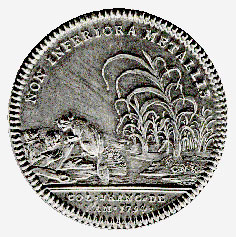New France, Franco-American Jeton, 1740
By Library and Archives Canada | Monday, March 29, 2004
In the days before adding machines and other automatic calculators, Europeans used jetons or counters for carrying out simple arithmetical calculations. For example, if livres, sols and deniers were being added in France or pounds, shillings and pence in England, a box with three compartments would be used, one for each denomination.
Jetons would be dropped into the respective compartments as the amounts to be added were given. When there were twelve jetons in the denier (penny) compartment, they were removed and a jeton placed in the sol (shilling) compartment, and when there were 20 sols (shillings) they were removed and a jeton placed in the livre (pound) compartment. Jetons were coin-like in appearance although they did not have any denomination. They were usually struck in brass or copper but occasionally silver and even gold was used. Many were beautifully designed pieces struck to honour distinguished individuals or to commemorate important events. During the reign of Louis XV the French mint issued a series of copper and silver jetons to commemorate the colonization of Canada and Louisiana and to recognize the importance of the increasing trade with the New World. All of these jetons bore a bust of Louis XV on the obverse and a design relating to the New World on the reverse.
The jeton illustrated is dated 1754 and shows two beavers at work building a dam. The inscription "NON INFERIORA METALLIS" points out that beaver skins were no less valuable than precious metals. This is believed to be the earliest use of a beaver on a numismatic item relating to Canada. This jeton is in the National Currency Collection, Bank of Canada.

New France, Franco-American Jeton, 1740
This article represents a portion of the the article titled Currency Museum of the Bank of Canada
More articles
- Canadian coins
- Canadian banknotes
- Canadian tokens and medals
- International
You can submit your own articles by contacting us.



